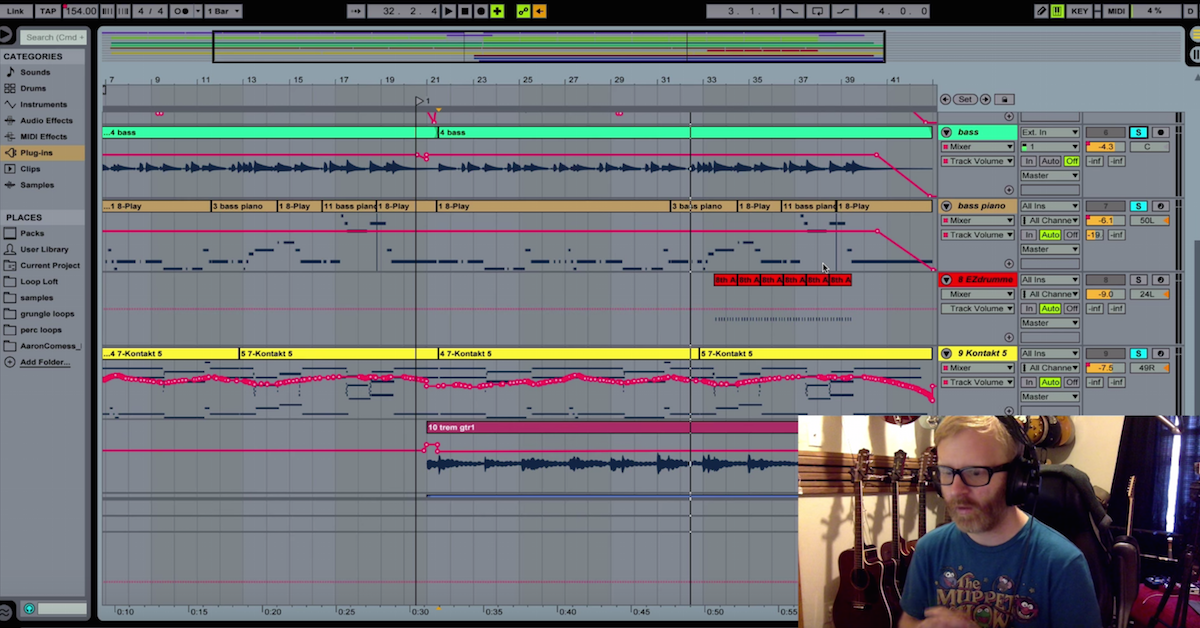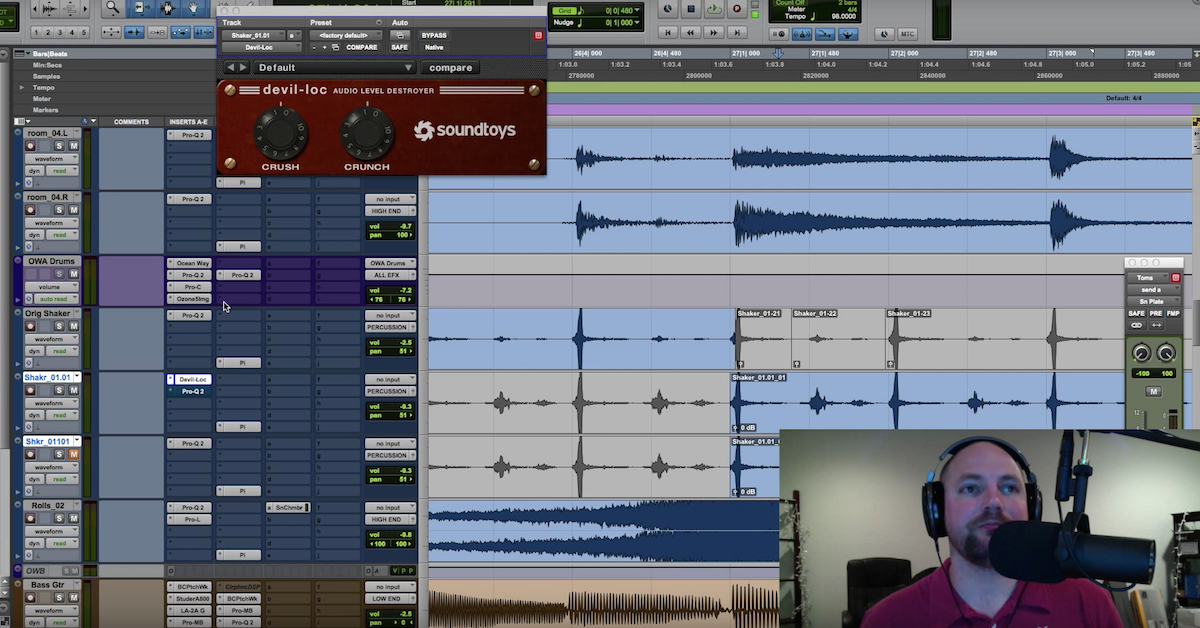Percussion: The Unsung Hero Of Groove
Article Content
Tambourines, shakers and cowbells have been the butt of many a joke between musicians and engineers for decades, but joking aside, they’re actually invaluable tools that can have a considerable effect on the feel of a track.
On that note, let’s look at five ways that layering some additional percussion can help enhance the rhythmic progression of your songs and get them grooving.
1. Filling in Gaps
If you have a slower track with a sparse and straightforward, 4/4 drum beat with 8th note hi-hats, there will be a decent wait between each hit — which can make it difficult for some listeners to comfortably lock-in with the groove.
In these situations, adding an accented 16th note shaker or tambourine can help fill in the gaps between each hi-hat while serving as a kind of rhythmic “washiness” or “glue” around the entire beat, making it significantly easier to latch on to.
Although they may not even be blatantly apparent at first listen, the shakers in Metallica’s “Sad But True” are a perfect example of percussion being used to “fill-in” a slow-tempo rock beat.
Take a listen and think about it, if you were to remove the percussion from the mix, then all you’re left with is a bare-basic drum beat which is only really emphasizing the quarter-note downbeats (the 1, 2, 3, 4).
In this case, the shakers are acting as a link between each downbeat, tying the open hi-hats together, and accentuating the upbeats (the 1, &, 2, & 3, &, 4, &). The result is a sort of “chugging” effect which helps shift the overall focus from quarter notes to eighth notes.
Long story short … does percussion have a place in heavy metal? I think the clear and resounding answer is: YES!!!
2. Building Momentum & Adding Lift
An essential practice in keeping listeners engaged from start-to-finish is to periodically introduce new musical elements and change things up a bit as your songs progress from section-to-section. Ideally, each time a part of the track repeats, you should be adding in something new to perk people’s ears and give them a sense of growth and momentum.
Think of it this way: if you have three choruses, but they’re all instrumentally identical, then the song isn’t leading anywhere and there is no explosive “payoff” to get fans to replay the song and relive the excitement.
As simple as it may sound, adding in some percussion on the repeats of sections can be the perfect way to “lift” the overall vibe and keep things rolling along nicely.
Mastodon’s “Show Yourself” is a killer example of this, and proves how some strategically-placed shakers and tambourines can be all it takes to do just that. Pay close attention to how the percussive elements are being used, the patterns being played, and how their stereo placements change throughout the track.
3. Widen the Stereo Image
Stereo width is all about difference. The more varied the signal in the left speaker is from the signal in the right, the more our ears are drawn away from the center, and out towards the sides.
The Rolling Stones’ classic “Sympathy For The Devil” is an excellent example of how syncopated percussion parts on opposing sides of the stereo field can make for a super-wide mix. The fact that all of the parts are played live and unedited also goes a long way towards creating fluctuation and contrast between each side.
Although this is a reasonably extreme example of how panning can be used to widen a mix, I think you get the point: If you’re looking to achieve a wide mix — always pan with a plan!
4. Enhancing the Beat
When programming acoustic drum parts that are meant to sound like an actual drummer, you may want to consider layering in some additional percussion tracks instead of damaging the integrity of what’s realistically playable by layering in tons of extra cymbal and shell hits.
In Ariana Grande’s “Greedy”, the drums are playing a no-frills, four-on-the-floor beat which is blatantly designed around driving the song. In the chorus, the primary beat remains the same, while a plethora of additional percussive elements is introduced to help supplement what’s already there without detracting from the aforementioned “drive”.
Remember: Simplicity is vital when looking to create effective drum parts that’ll get people dancing. Identify what’s most important, and make sure you don’t ruin it by overdoing things!
5. The Human Touch
Given the fact that it’s relatively difficult to perform a 16th note shaker or tambourine part 100% accurately, these sorts of percussive elements can be great for injecting a sense of “human realism” into heavily edited and programmed modern music.
Back in the day, music wasn’t recorded to a click or perfectly time-aligned to a grid. It was often recorded live, with the entire band (or part of the group) playing together in a room while simply vibing-off each other’s energy and performances.
Aerosmith’s “Sweet Emotion” is a great example of a classic rock song from the ’70s which is “perfectly imperfect”. Just listen to the inconsistencies in the shaker performance and how the accents don’t always fall on the same beats. It pushes & pulls in an attempt to stay in time and drastically speeds up just as the intro transitions into the verse.
The bottom line is, although it’s important to always strive for consistency and accuracy in your recordings, it’s also important to understand that human beings are imperfect by nature. So if you’re looking to retain a level of realism in your productions, the simple answer is to not edit everything to “perfection”!
This same trick can also be applied in electronic music. If you have a programmed electronic kick & snare which are totally locked into the grid, and you just add in a hi-hat (or ride) which has actually been performed by a real human being, the result is a much more organic sounding overall beat due to the non-linearity in the dynamics.
Conclusion
Quite honestly, bringing percussion into the mix is one of my favorite parts of the music production process. It’s just so satisfying hearing how a simple shaker or tambourine can elevate a track to new levels and act as the final icing on the cake.
All of this being said, just because you can doesn’t mean you always should … make sure that if you’re adding percussion to a track, it actually fits the context and improves on what you already have!


![Mastodon - Show Yourself [Official Music Video]](https://i.ytimg.com/vi/gUGda7GdZPQ/hqdefault.jpg)







